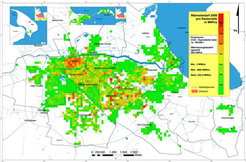IPP participating in "The Energy Efficient City" competition
"Energy Efficient Oldenburg" project started / IPP develops city model for Oldenburg

In the next round the competitors selected are to elaborate their ideas into detailed concepts with financial support from the Federal Ministry of Education and Research. In order to reduce carbon dioxide emission and use energy more efficiently, the city of Oldenburg has joined forces with three research partners – besides IPP, the University of Oldenburg and the Institute of Information Technology (OFFIS) – together with energy supplier EWE and project coordinator RIS-Energie.
The basis will be an energy model for Oldenburg and its 160,000 inhabitants to be developed with IPP in overall charge. IPP’s Energy and Systems Studies group has for many years been investigating energy models for cities as elements of a comprehensive “world model" describing the future development of the energy economy in global terms. These investigations are an accompaniment to IPP’s physical research on nuclear fusion energy.
For the Oldenburg energy model the scientists from IPP are following up on models already developed for Vienna, Greifswald and Augsburg (see IPP Press Release 10/06). On the basis of city data the model is to make power and heat consumption in Oldenburg and energy expended in road traffic numerically tangible. The results expected from a variety of measures – municipal planning projects, municipal redevelopment, mobility concepts or modifications in the energy supply – can then be calculated and assessed in respect of energy requirements and emissions. As a basis for decisions by the city, companies and households the model is to help in estimating saving potentials and assessing the effectiveness of various strategies.
In Oldenburg attention is being given to a greater involvement of consumers than hitherto. If the consequences of individual action can be made visible, it will be possible to sensitize people to the subject of energy. Furthermore, energy consumption and emissions are to be investigated not only in the areas of traffic, habitation and work, but also in the services sector – hitherto rather a blind spot in efficiency strategy. It is of course also particularly difficult to grasp systematically how much carbon dioxide accrues from, for example, tax consultation, shopping or attending the doctor and what conclusions can be drawn for municipal planning and energy supply.
The two objectives are to be achieved by IPP by providing in each case a simulation for Oldenburg's households and for the three service sectors, health, schools and the retail trade. Besides the classical energy chains, the two simulations must also include typical procedures in households, hospitals, schools or shops. If new elements are then incorporated, e.g. modified size and distribution of supermarkets, it is possible to determine whether consumption can be reduced. In this way energy requirements and emissions for different scenarios can be compared.
The 15 projects selected now have a year and a half to elaborate their concepts. A maximum of five projects will then proceed to the next round of the competition. These can then each look forward to receiving for three to five years a grant of about a million euros per annum for implementing the elaborated concept.
Isabella Milch
